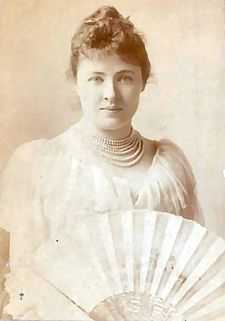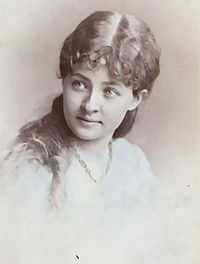Sadie Martinot
| Sadie Martinot | |
|---|---|
 New York Public Library Digital Gallery c. 1880s | |
| Born |
Sarah Frances Marie Martinot August 19, 1861 New York City |
| Died |
May 7, 1923 (aged 61) Ogdensburg, New York |
| Occupation | Actress and singer |
Sadie Martinot (August 19, 1861 – May 7, 1923), was an American actress and soprano singer who performed on stage in dramas, musical comedy and comic opera. Her career began at the age fifteen as Cupid in Ixion; or, the Man at the Wheel and, but for a few years absence, would remain active on stage in America and abroad until 1908. She was the first to play Hebe in an American production of H.M.S. Pinafore, the first Katrina in the comic opera Rip Van Winkle and the first to play the title role in an English adaptation of the operetta, Nanon. Late in her life Martinot would fall victim to mental illness and spend her last few years confined to psychiatric institutions.
Early life
She was born Sarah Frances Marie Martinot in New York City on December 19, 1861, the daughter of William Alexander and Mary Lydia (née Randall) Martinot. Her father was the son of John P. Martinot, a French immigrant who founded a successful wholesale firm dealing in imported silk products. William Martinot worked for his father's firm and had served in the American Civil War[1] and later as a New York City police detective who once brought charges of corruption against a NYPD police captain.[2][3] Her mother was said to be of the family that once owned Randall's Island in Manhattan.[3] Before taking to the stage at fifteen, Martinot was educated at area public schools and the Ursuline Convent in New Rochelle, New York.[4][5][5] Some accounts[4] have her birth name as Sally Martin or Sally Eagan, the daughter of an Irish-American single mother who worked hard to ensure her a good education. In March, 1894 Martinot stated to the press that, though she would have been proud to have been raised under such a circumstance, she in fact was the daughter of Mary and William Alexander Martinot.[6]
Career

In 1876 Martinot joined Manhattan's Eagle Theatre as a $5 a-week walk-on player. Her debut came about in late August of that year when an injury prevented chorus girl Maude Branscombe from performing Cupid in that evening's performance of F. C. Burnand's Ixion.[5][7] The next year she joined Adah Richmond's company at $18 a-week, touring in Chow Chow: or, A Tale of Pekin,[8] in which she performed a popular imitation of Marie Aimee,[9] singing Pretty as a Picture[10] Later came a Christmas, 1877 engagement at the Boylston Museum, Boston [11] and a performance the following year at the city's Americus Club that led to an offer to join the Boston Museum stock company. That November she appeared at the Boston Museum in the original American production of Gilbert and Sullivan's[12] H.M.S. Pinafore and, over the following few seasons, rose to be their leading soubrette. Martinot left The Boston Museum after actor-manager Dion Boucicault offered her a substantial raise to join him in England and her request for a modest salary adjustment was rejected by the Museum's management.[5]
Martinot made her London debut on Boxing Day, 1880 at the Alhambra Theatre as the Spirit of the Bracken in the three-act comic opera Mefistofele II.[13] At the same theatre the following March, she played Celine in the Opéra bouffe Jeanne, Jeannette, et Jeanneton.[14] On October 14, 1882 she created at the Royal Comedy Theatre, London, the role Katrina in the comic opera Rip Van Winkle.[5][15]
By 1883 Martinot was back in New York with Boucicault for the inaugural season of his new Star Theatre (formerly Wallack's Theatre). Their first production premiered on March 26 with Boucicault's Vice Versa with Martinot in the role of Mrs. Clingstone Peach. Later one critic would declared the piece a failure and Martinot a success. On April 12 the season continued with Martinot playing Moya in The Shaughraun; Dora on April 19 in The Omadhaun; and that May as Eily O'Connor in The Colleen Bawn.[5]
At the Fifth Avenue Theatre in January, 1884, Martinot played Portia in the farce Distinguished Gentleman and that August at the Union Square Theatre she was Florence Nightingale Fletcher in Queena. In April of the he following year she played Sophie in Dakolar at the Lyceum Theatre and on June 29, 1885, at the Casino Theatre, she became the first to sing in English the part Nanon Patin in the operetta Nanon.[5][16]
Illness
In December, 1885 Martinot sailed for an engagement in Florence, Italy, where after a short period she came down with a strain of malaria commonly called Roman Fever. A private train took her to Vienna, Austria where she spent the next several years convalescing and, as her strength returned, pursuing European art and culture.[5]
Later career

Martinot returned to New York to star in the much anticipated comic opera Nadjy, but after a disagreement with the Casino Theatre stage manager, she withdrew from the production before the piece debuted. Her first performance after returning from Europe was played in German at Amberg's German Theatre early in 1889 as Bettina in Das Maskottchen (The Mascot). At the Garden Theatre on September 27 of the following year she played Mrs. Horton in Hamilton Aide's Dr. Bill[17] and at the same venue that October 6, Lois in Jerome K. Jerome's Sunset . Over the following two seasons Martinot starred in a national tour performing the title role in the Charles Frederic Nirdlinger play Pompadour and Dora in Victorien Sardou's Diplomacy. Martinot would remain active in theatre, in New York or elsewhere, well into the first decade of the new century in roles such as;[18]
Suzette in The Voyage of Suzette (1893)[19]
Mrs. Darcey in The Passport (1894)[20]
Lady Angela in Patience (1896)
Hattie in A Stranger in New York (1897)[21]
Leonie in The Turtle (1898)[22]
Lady Carnby in The Marriage Game (1901)[23]
Paula in The Second Mrs. Tanqueray (1903)
Mary Erwin in Mary and John (1905)[24]
Mrs. Temple in Mrs. Temple's Telegram (1906)[25]
Lady Dover in Toddles (1908)[26]
Personal life
Martinot married twice, first to Fred Stinson (d. 1895),[5] a theatrical manager, on March 30, 1879 in Boston, and then to Louis F. Nethersole (d. 1936), a theatrical manager, producer and press agent and a brother of actress Olga Nethersole. While it was reported she married, Max Figman, a comedian-actor, with whom she fell into financial difficulty, her marriage record to Louis Nethersole on May 30, 1901 in Manhattan, New York, lists her name as Sarah F. Stinson.[27] At the time of her death Martinot was thought to be divorced from Nethersole.[5][28][29] Martinot was the author of a number of magazine articles over her career, a student of Wagnerian opera and an accomplished equestrian.[5]
Decline
On January 5, 1916 Martinot jumped unclad from a second story window of an apartment building on Fort Washington Avenue, New York. She did not, from press reports, appear seriously injured when she landed in an adjacent courtyard, though it was apparent she was mentally unstable. Martinot was transported to Washington Heights Hospital and then later in the day transferred to the Psychiatric Ward at Bellevue Hospital.[30] In March, 1918 Martinot was committed to the Manhattan State Hospital for the Insane and later that year moved to St. Lawrence State Hospital, Ogdensburg, New York. At some point early in 1918 Martinot escaped her confinement and was eventually found in Washington, D. C., disorientated and unable to recall her name. She died of heart disease five years later while still institutionalized at St. Lawrence Hospital.[28]
References
- ↑ New York in the war of the rebellion, 1861 to 1865, Volume 5, 1912, p. 3847 accessed 6.16.13
- ↑ Capt. Burden's Trial. New York Times August 3, 1875; p. 8
- ↑ 3.0 3.1 White, James Terry, The National Cyclopedia of American Biography,1904, p. 556 accessed 6.15.13
- ↑ 4.0 4.1 Grau, Robert, Forty Years Observation of Music and the Drama, pp. 156, 221-222 accessed 6.14.13
- ↑ 5.0 5.1 5.2 5.3 5.4 5.5 5.6 5.7 5.8 5.9 5.10 Opera Glass, May, 1896, pp. 67-78 accessed 6.14.13
- ↑ Gossip of this Town. Elmira (New York) Telegram, March 4, 1894, col. 6 accessed 6.15.13
- ↑ Bernard, F. C. Ixion; or, the Man at the Wheel accessed 6.7.13
- ↑ Chow Chow: or, A Tale of Pekin, Internet Broadway Database accessed 6.14.13
- ↑ Note: a well-known French prima donna
- ↑ Daniel H. Morrison, The Treasury of Song for the Home Circle, 1892, p. 418 accessed 6.14.13
- ↑ Music and the Drama. Boston Daily Advertiser (Boston, Massachusetts), December 24, 1877; Issue 150; col. D
- ↑ Note: though without their permission
- ↑ by Hervé (composer), with book by Georges Jacobi and C. Alfred Maltby Mefistofele II: Grand Spectacular Comic Opera in Three Acts accessed 6.9.13
- ↑ Paul Lacôme(composer) with book by Charles Clairville and Alfred Delacour
- ↑ based on the Dion Boucicault and Joseph Jefferson theatrical adaptation of the Washington Irving story
- ↑ by Friedrich Zell and Richard Genée Brainard's Musical World, Issues 262-335, 1885, p.389 accessed 6.14.13
- ↑ adapted from Le Docteur Jo-Jo by Albert Carrt
- ↑ Who's Who in the Theatre, 1916, p. 417 accessed 6.16.13
- ↑ Note: from Le voyage de Suzette by Léon Vasseur
- ↑ Note: by B. C. Stephenson and William Yardley - based on the novel My Official Wife by Richard Henry Savage - Sadie Martinot's Tour Begins. The New York Times October 16, 1894, p. 5
- ↑ Note: by Charles Hale Hoyt
- ↑ Note: adapted by Joseph W. Herbert, from La Tortue, by Léon Gaudillot - Brown, Thomas Allson - A History of the New York Stage, 1903, p. 269 accessed 6.16.13
- ↑ Note: adapted by Clyde Fitch from Mariage d'Olympe by Émile Augier
- ↑ Note: by Edith Ellis Baker
- ↑ Note: Mrs. Temple's Telegram by Frank Gunning Wyatt, William Morris accessed 6.16.13
- ↑ Note: by Clyde Fitch adapted from a French farce Bell, Archie - The Clyde Fitch I Knew, 1909, p. 119 accessed 6.16.13
- ↑ Sadie Martinot in Court Again. The New York Times, March 25, 1896, p. 10,
- ↑ 28.0 28.1 Sadie Martinot Dies Insane at 61.The New York Times, May 8, 1923, p. 7
- ↑ The New York Clipper Annual' 1880, p. 16 accessed 6.16.13
- ↑ Miss Martinot in Hospital. The New York Times, January 6, 1916, p. 11